The path to honey is a long and arduous one. Arguably it starts in September after you’ve extracted your summer honey. Then the beekeeper can treat for varroa and prepare the colony for winter. As the cold nights draw in mouse-guards go on, insulation can be put in the roof and the long wait to see whether the bees will survive winter begins.
Come spring, if all goes to plan and your bees have emerged healthy and well, you may be able to put supers on in April or May. The bees fly high and far, gathering nectar wherever they can. You inspect and wait, making sure the queen is laying and preventing any swarms occurring.
Finally, after much heavy lifting, stings, breaking of nails, splinters, sweat and pain, hopefully the bees have managed to fill and cap a super(s). Now is honey time. But your efforts are not over yet. In fact, some of the worst times are still to come – do any beekeepers really genuinely enjoy honey extraction?
The job that faces you first (at least for frames built from foundation) is to uncap the heavy honey frames, using a knife or uncapping fork. This is best done in hot weather (to help the honey flow) in a room with all the windows closed (to stop the bees and wasps coming to get their honey back).
Here’s the resulting wax cappings. These can be given back to the bees to clean up and then turned into candles or wax blocks afterwards. Ideally nothing goes to waste. The heady, almost boozy scent of the honey rises around you. A few licks are all it takes to start feeling slightly sick from the sweetness. I understand why bees go into a robbing frenzy if honey is spilt around the hives – it’s an enveloping, intoxicating smell. Your hands are covered with gooey, sticky honey by this point – probably along with your clothes, the floor and everything around you.
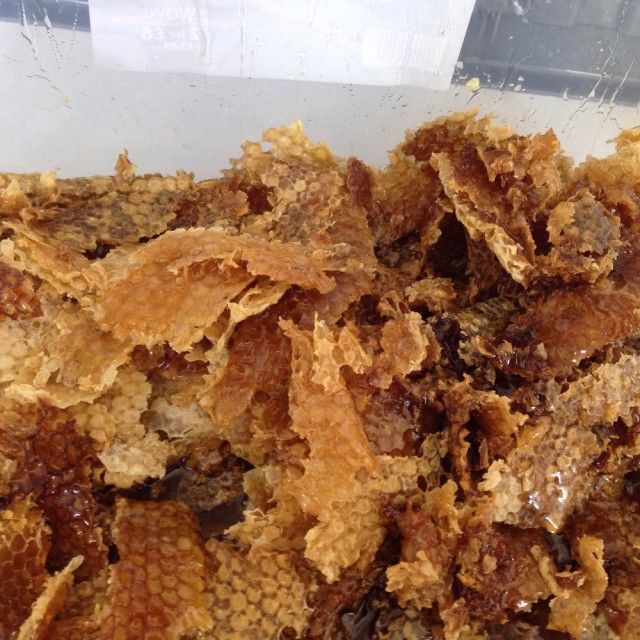
Once you’ve uncapped the honey, now you can spin it out. Last year we got to this stage and put the frames in Emma’s extractor, only to find nothing came out. We had extremely stubborn, viscous honey. It must have been thixotropic, which means that it becomes temporarily fluid when shaken or stirred but a gel again when left standing. We got all sorts of sceptical looks from other beekeepers who hadn’t experienced this when we told them about it! People kept asking whether we’d uncapped the frames properly or said we weren’t putting enough welly in (despite it being an electric extractor which span faster than any human!).
In the end Emma had to stir each cell individually with a sterilised key to get it to flow out – see her post, ‘How to extract honey too thick to spin out of a perfectly good extractor‘.
This year my allotment honey was a dark, rich brown. Would it spin out?
Much to our relief, the answer was yes. We took turns cranking the handle around, with Emma’s boyfriend John joining in at one point too. A tiring job but at least we could see results as the honey gradually built up at the bottom of the extractor. We drained the extractor after every super of frames, as it can only be used whilst on the floor and then must be lifted up onto a surface so that the honey can flow into a container below. If you extract too much honey before draining it, the extractor will be extremely heavy/impossible to lift!
The honey you can see oozing out above is lighter honey from our apiary hives. Emma has some more photos of the extraction at http://missapismellifera.com/2015/07/25/a-beekeepers-notes-for-july/
The job is not over yet, as the honey must be filtered through a sieve to remove wax particles before finally being bottled. I hope this post conveys some of the work hobby beekeepers go through to produce honey and explains why local honey costs more than the mass produced supermarket kind, which has been churned together from multiple hives and sometimes even from colonies in several different countries. This process, in combination with intense micro-filtering and pasteurisation by heating, usually results in a loss of flavour.
By the way I’d be interested in hearing from other beekeepers as to how you store your honey. I saw keeping it in a fridge or freezer recommended in a magazine this month, as at under 4.5°C granulation stops. Have you ever done this? And what did your family think about the fridge or freezer being full of honey?!

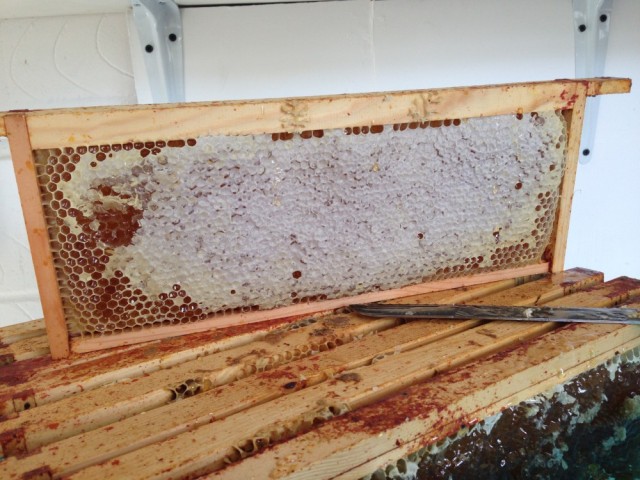
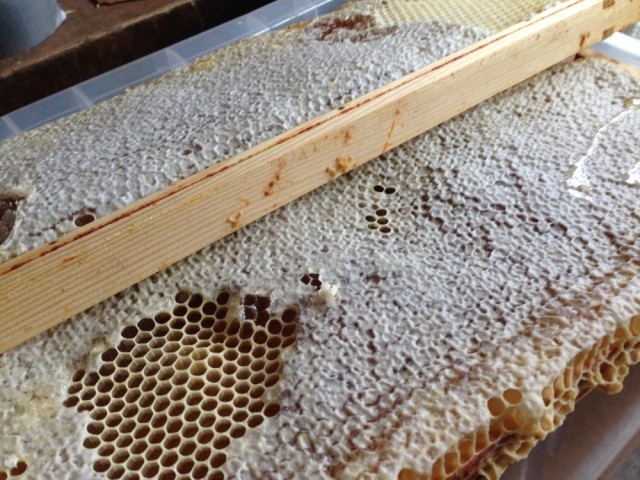
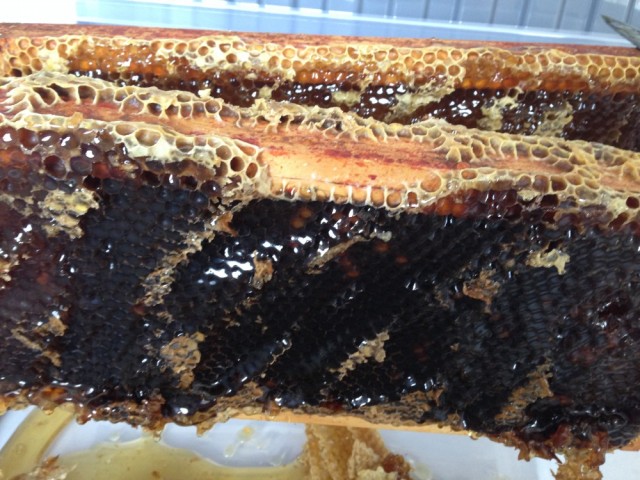
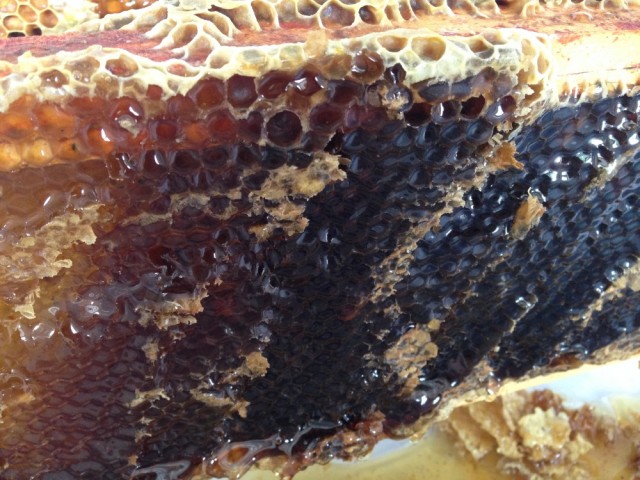
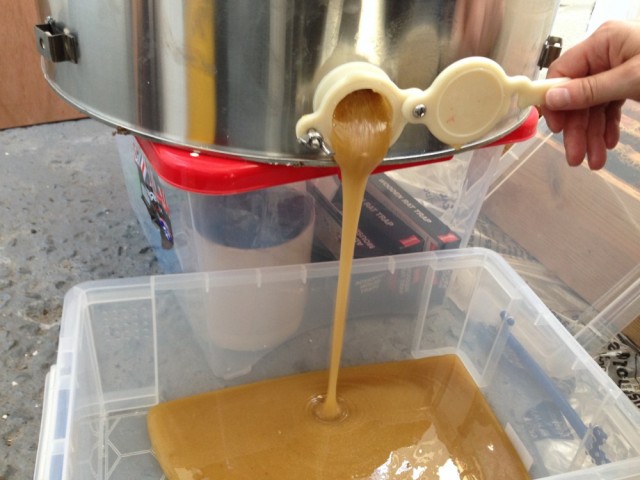
Well done! I loathe extracting, love the outcome! This year a bunch of my bee club friends came over to help out (I was really touched by that) and I set up the garage assembly line style with three banquet tables and stations. Uncapping was the bottleneck to speedy processing. It was a lot of fun doing it together, and we had a big pizza party on my patio after. Lovely, just. Emily, you are invited to our 2016 Honey-ing : )
LikeLike
Ah great, how kind of them! Would love to come to the 2016 honey party!
LikeLike
. . . my hobbies don’t sound too bad now . . . not sure I would add this one although the allure of it is still there even after reading all this.
Funny, though . . . many previous posts concentrated more on the camaraderie and the positive aspects of the process (fun, food, and friends).
LikeLike
There are positive aspects of course, though for me they are to do with the bees and chats over tea more than the honey. It’s a hobby I am very up and down about at the moment, sometimes I love it and other times I’m close to giving up so I have more spare time at weekends.
LikeLike
Well, if you are planning on handing the hives over to someone wanting to get into beekeeping you need to spruce up the narrative a bit . . .
” . . . my favorite part of beekeeping is honey extraction. The heady aroma of fresh honey, the tactile feedback of bee’s wax mixed with the luxuriously viscous feeling of freshly flowing honey is something to be experienced as no words can capture the ecstasy of it. You too can enjoy the experience of being one with nature’s ambrosia; please contact (enter info here) to discuss this amazing opportunity of becoming the owner of a working beehive. Experience nature, experience life.”
. . . or something along those lines.
LikeLike
Ha! Yes, best enjoyed naked so you can truly be at one with nature’s stickiness.
LikeLiked by 1 person
. . . ! . . . uh . . . the hidden part of beekeeping that I don’t know about?
LikeLike
Yeah… no photos of that part.
LikeLike
. . . I’ll never look at a jar of honey the same way again.
LikeLike
I’m having an awful honey year so will head for the Heather moors in August. As to storing – I leave it all on the kitchen shelf and any that crystalises I gently warm until runny for use 🙂
LikeLike
Ah no! Interesting about going to the heather. How do you extract that, I’ve read that it’s thixotropic?
LikeLike
I don’t mind the faff of honey extraction. I’ve found that if I uncap directly over the extractor and let the cappings fall in then the stickiness is contained. I do store cut comb in the freezer to kill off any wax moth larvae, but other honey just gets jarred and put on a shelf. I noticed that some of the jars near a cold window last winter started to crystallise, so I moved them into a warmer spot.
Thanks for a great post – your honey looks beautiful!
LikeLike
Thanks Helen, that’s interesting. So would you let the honey pour out of the extractor and then fish the cappings out afterwards?
LikeLike
I empty the honey and cappings into a filter over my settling tank. Once the extractor is empty I put cling film over the top of the filter and leave it for a few hours. Once the honey has drained through I just rinse off the cappings and they are ready to do whatever…
It probably isn’t the fastest method, but I really like the fact that most of the stickiness is contained!
LikeLike
That sounds pretty clever! It does require a settling tank, which we don’t have at the moment. I like the idea though.
LikeLike
I’ve used a heating gun to melt my wax cappings open over the past few summers. So far so good, and I never have to clean up any cappings afterwards. When the cells melt open from the heating gun, most of the wax hardens right on the comb. I have video of it posted somewhere.
LikeLike
I would be fascinated to know where your black allotment honey is coming from ,it looks like honeydew honey, are there any pine woods in the area (or piles of part-empty cola cans?)
Sometimes you can get less and finer cappings by scratching the comb face with a sharp uncapping fork and putting the scuffed combs straight into the extractor. These fine cappings rise to the top so only the final flow out is waxy.
To avoid your lifting caper I have made a stand for the extractor frame to be screwed onto, out of a 50cm square of thick shuttering ply(or worktop offcut) on a cross of 23 cm floor joists,, this leave room under the tap for a bucket to take the regular outflow. The last bucket should have most of the scraped cappings in.
Beekeepers should never pass builders’ skips without inspection for useful wood and ply for such things!
LikeLike
A lot of Ealing beekeepers have had this dark honey this year. There is talk of it possibly being chestnut honey. Our part of London lacks any pine woods! But there are aphids on the trees lining the allotments of course. The strong floral taste tells me it’s not cola, phew.
Thanks for the uncapping tip! I like the sound of your extractor frame, very smart.
LikeLike
Crush and strain is definitely more fun and the kids love getting involved 🙂
LikeLike
Sounds good! I’m also tempted to do some foundation-less combs next year and do pretty cut-comb honey.
LikeLike
Agreed It does look like Chestnut honey but are there sufficient Sweet Chestnut trees in Ealing to affect the whole town? It looks absolutely delicious wherever it came from.
,
LikeLike
Not sure – we have loads of horse chestnuts though, would they also produce dark nectar? Should get some analysed and find out! The experienced beekeepers have been complaining as dark honey does not sell as well, the public are reluctant to try it.
LikeLike
I believe Horse chestnut is quite a light honey, so I would suggest that a more likely source might be honeydew from sycamore and plane trees.
It would be intriguing to get it tested..
I have in the past swapped similar dark honey for some very light rape honey (from a friend) and the mixture looked a nice colour and tasted very good and sold well..
Rape on its own can look very anaemic and the dark helped visually..
Black honey is a delicacy in many parts of Europe, but not yet here..
LikeLike
Oh. that honey looks scrumptious. I do like the darker honey we get sometimes here from the keepers.
LikeLike
Thanks Donna, I’m glad you like it as the darker honeys can be more difficult to sell here.
LikeLike
Just purchased some yesterday. I should have asked about what flowers the bees were visiting.
LikeLike
Hope you enjoy it 🙂 unless the hives were next to a major crop the beekeeper may not have known, the pollen the bees bring back provides clues but often it’s guess work to know what the bees have been finding.
LikeLike
Ha ha Emily. You’ve discovered the stickiness of extraction. I was banished to the garage long ago by my better half for covering the kitchen in honey and, worse of all, propolis. Be careful though of other chemicals in your garage as the smells can taint the taste of your honey.
As far as storage is concerned take a look at the honey buckets made in food grade plastic, sold by all the main suppliers. It does mean you don’t have to bottle all at once, although you may have to borrow a honey warming cabinet to make the honey runny enough to pour. All honey will granulate (crystallise) with time, it’s a sign of its quality. Some honey granulates faster due to a higher ratio of sucrose to fructose. Here in the Home Counties, we have a lot of Oil Seed Rape grown in the spring. That honey has to be extracted as soon as, otherwise it sets in the comb.
Great blog. Thank you. Simon
LikeLike
Ah, there are no garages in my part of London! I like the honey bucket idea. We have been lucky as our honey has always been extremely slow to crystallise. Glad we don’t have your oil seed rape honey, that sounds very tricky to deal with. Can’t see the Flow hive working for you!
LikeLike
I find extracting such a two-edged sword. I always am excited when my hives begin to fill with capped honey and I’m keen to get a taste of it, then the day comes to don the hot suit and face the colonies – ugh. We have about 2 dozen hives and it takes a week of full time effort to extract. Yes, we have a hand-spun extractor, that’s my job. Hubby uncaps, I spin. We both end up hot, sticky and tired. But it is quite the sense of accomplishment.
The only thing we do differently than you is we don’t feed the cappings back to the bees. We squeeze it and strain it to get another couple kilos of honey. Then we put it in our solar extractor. The wax melts and runs through a sieve. The honey and wax separate in our catch tray so when the wax hardens we can pour out the honey. This honey has been heated (by the sun through glass) and so has lost some of its goodness but is fantastic for baking (where the honey gets heated anyway). It’s thicker, darker and stronger tasting. Some people prefer it for eating but since it’s been heated, I save it for cooking. The wax goes through the melter/sieve one more time and then gets poured into blocks for later use. Sometimes this process takes months (waiting for good, warm weather and motivation after the exhaustion of extraction) but yields us several more kilos of honey each year.
As for storing the honey, we use 25 kg food-grade buckets. If it starts crystallising in the buckets we try to fill jars faster. Once we run out of jarred honey and need to fill more from buckets that have hard honey in them, we put a bucket in a tub of warm water for a couple of days to soften and then empty the entire bucket into jars. Basically each bucket gives us 50 jars which is a lot to deal with and no way would I put our whole harvest which is about 300 kg into jars in one go – 600 jars is a bit intimidating!
LikeLike
I really admire you spinning out all those frames, you must have great arm muscles by now! Your wax extractor method is very efficient, sounds like not a single drop is wasted. Fascinating to hear how different people go about it, Simon also mentioned food-grade buckets in his comment above.
LikeLike
That dark honey looks delicious, though I do understand how the general public, not used to variations in honey, might be leery. Thanks so much for sharing the process and photos! They add to my already high appreciation of our local beekeepers.
LikeLike
Thanks! Hopefully if people try some of the darker honey they will be won over.
LikeLike
That honey looks so different to our honey – It always amazes me the variation in honey, even from a relatively narrow geographic range, but I’ve never seen any like that before.
Al.
LikeLike
Indeed it is amazing. The England Honey Regulations 2015 allow for the variation in colour by saying honey colour can vary from ‘nearly colourless’ to ‘dark brown’.
LikeLike
I put as much of my bottled honey in the freezer, my comb honey too. I always tell people who get more than a jar of my honey to put the jar they’re not using in the freezer. Like you said, it put the granulation process in suspended animation. The best of both worlds is honey that starts off liquid and gradually becomes crystallized but soft and buttery.
The honey coming out of the extractor in the photo looks almost creamy.
What do you use to filter your honey? I’ve been using a paint strainer in my collection bucket so the first thing the honey hits when it leaves the extractor is the strainer, but that process severely slows down the extraction, waiting for the honey to filter through.
LikeLike
Thanks Phillip, good to hear from someone who has tried the freezer option. Does it have any impact on the flavour afterwards do you think?
I’ve just been using a standard kitchen sieve to filter it, which will get the biggest particles of wax etc out. It’s looking ok afterwards but is probably not as finely filtered as yours.
LikeLike
Freezing has no impact on the flavour, none that I’ve noticed. There’s also so little expansion of the honey when it freezes, there’s no risk of the jars cracking. I still have my very first jar of honey from 2011 in the freezer.
LikeLike
Excellent, that’s good to know. I shall store some of mine away in my freezer then.
LikeLike
Hi Emily. I like your blog. I have 3 hives and this is our first year that we will be getting enough frames to harvest. Maybe we will be able to do it in a few weeks. I can’t wait. Last year we got 2 frames of honey, but did not extract that small amount. I put them in the freezer instead. I decided I would save them for the bees or for me. We made a warmer out of an old refrigerator and it has a lightbulb in it and a thermostat that goes to 85 degrees F. My teacher said that we can warm our frames of honey the day ahead so the honey comes out easier. I plan on trying this with my frozen frames for sure. You do not want to go any higher than 95 degrees, because that would heat it too much. (so I’m told.) Thanks for your pictures they are really good.
LikeLike
Thanks Ellen, it took me a while to get my first honey harvest too. Clever of you to have made your own honey warmer!
LikeLike
Have several frames ready to extract but I’m putting it off by reading your lovely post. Beautiful honey. So dark!
LikeLike
Thanks Michelle! Of course it was the clever bees that did all the real hard work. Your blog looks great, have signed up to it 🙂
LikeLike
Ah, nice to be back online finally and able to catch up on blogs. Your post reminds me what a fun day we had extracting all that honey, even if it is also hard work 🙂
LikeLike
Good times 🙂 Was lovely having such a perfect space to do it in, with friendly fish to meet afterwards.
LikeLiked by 1 person
Nice job Emily. I also have the same dark honey that comes at the end of the year. I pulled some supers off earlier this year at the end of May and the honey was much lighter and runnier as well the flavor was much more floral. I do believe you have Japanese Knotweed (Fallopia japonica)over there. This plant is part of the same family as Buckwheat which has a dark honey. I find my honey from later in the year to be tangy with a bit of a bite to it.
I also don’t find extracting a fun job but investing in some sort of a power option on the extractor and a good way to decap the frames with a nice big tray below is essential to make life easier. Also investing in a sieve that fits into a pail makes it easier.
i never really have any honey left after about January so dont have a problem with storage. i like to jar it in smaller jars (500ml or less) as i have found that the bigger jars tend to crystallize quicker. I have a few small 45ml hex jars from 2011 that are still crystal clear.
LikeLike
We certainly do have Japanese Knotweed but I didn’t know it made dark honey. That’s interesting, thanks. I like the sieve in a pail idea too.
LikeLike
Thank for beekeeping quality Iwill bee happy if send me 6 queen bees from your apiary
Best rgards,
Shehab KHanj
LikeLike
Thanks Shehab, but I don’t sell queen bees sorry.
LikeLike
Your photos and stories never fail to raise a smile however love this blog especially as drooling over all that magnificent honey!
LikeLike
Thanks Molly! The bees did do a grand job of making beautiful honey.
LikeLike
The extraction part doesn’t bother me in the slightest. I don’t do much of the handle cranking. It’s the wax processing that I would like to hand over to someone else.
It is spring where I am and it is too hot already but when I hear things like ‘whether the bees will survive winter’, I am glad to live here in Australia where the bees keep going all winter long.
LikeLike
Australia does sound like heaven for bees. I heard that the small hive beetle arrived recently though, which is a real shame. It’s so hard keeping all the pests and diseases at bay, even an ocean barrier doesn’t guarantee safety.
LikeLike
Wow that honey looks great. I don’t think I have ever seen that colour from any of my hives. Thanks for posting the photos though. I want to take the time to document the process and the progress of the hives through the seasons at some stage. Sounds like a lot of additional work though!
LikeLike
Thanks Becs. I know what you mean, writing on top of honey harvesting and everyday life can be hard work!
LikeLike